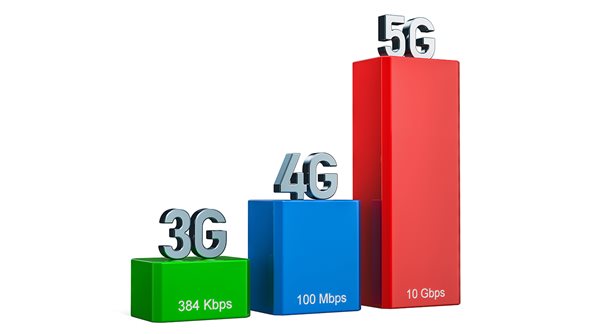Since the first analog systems launched in the late 1970s, cellular technology continues to rapidly evolve every decade with the next evolutionary step in network technology. Today, mobile network operators are deploying Long-Term Evolution (LTE) 4G and 5G networks and phasing out legacy 2G and 3G networks.
With the
2G/3G network sunset underway, not only must all remaining 2G and
3G mobile phone users upgrade, but commercial and industrial operations must plan their their migration as well, based on 4G LTE technology or the next generation — 5G. This article is intended to answer questions your organization may have about next steps for your 2G or 3G devices, and how and when to migrate to new technology.
In order to stay ahead of the
3G sunset, operations with deployed 2G and 3G devices should immediately consider their options and long-term needs to better prepare for the migration. If you need guidance, see our
network migration page to learn about our supporting services.
NOTE: Our cellular network migration blog series includes a number of articles to help you evaluate your choices:
Additionally, for those seeking migration solutions to 5G today, we have several additional resources:
What Is 3G Sunsetting?
 3G sunsetting
3G sunsetting means that a mobile network operator (or carriers) shuts off the cellular infrastructure required to operate communication devices based on 3G (UMTS, HSPA, EVDO) technology. These 3G networks are slower and less efficient than newer 4G and 5G networks, which share the same spectrum. 4G and 5G networks based on LTE technology were built with the long-term view in mind, and therefore have a long future for the next decades.
Device manufacturers around the world are now building and optimizing connected devices for these newer networks, and today, many carriers are no longer activating 2G or 3G devices.
Many 2G networks have already shut down and the full 3G sunset will follow, ultimately making these devices obsolete.
Why Do Carriers Shut Down Networks?
In many cases, the migration away from
2G and 3G networks is driven by the desire of mobile network operators to repurpose spectrum for faster and more efficient
4G LTE and 5G devices.
It is also more cost-effective to operate an LTE or 5G network than a 2G or 3G network, because more devices can share the available spectrum. Prior to sunsetting a network, mobile network operators may regionally repurpose spectrum or tune their radio access network. In these cases, 3G devices may slow down or lose connectivity ahead of the 3G sunset date.
There are other highly compelling reasons as well. Newer networks are not only faster, but they support many more devices. They are also far more
secure, robust and easy to maintain. These features of advanced networks make it all the more compelling for these shutdowns to be completed in the next year, but also for organizations and municipalities to plan their migration.
Do All Carriers Have the Same 3G Sunset Date?
The short answer is: no. However, as cellular technology continues to evolve and consumers continue to demand
faster, more reliable, and cost-effective connectivity, all carriers in the cellular space plan to migrate from second and third generation networks to fourth-generation LTE technology and 5G to free up available wireless spectrum.
For those planning migration,
4G LTE and 5G devices are both viable options, and will be for many years to come. This is especially useful to consider, as 4G networks are now viable in nearly all regions worldwide, while the full 5G build-out will take a number of years to complete. We will discuss this topic further in subsequent sections of this article.
When Will 3G Be Phased Out by My Carrier?

The
2G and 3G sunset is coming!
- AT&T has already shut down its 2G network and will fully shut down its 3G networks in February 2022.
- Verizon has also already phased out its 2G networks as of 2020, and will complete its 3G network shutdown by the end of 2022.
- T-Mobile plans to shut down its 3G network in April of 2022.
- Sprint’s 2G/3G CDMA networks are shutting down in January of 2022, although many carriers have had to push their dates out so we are keeping an eye on this schedule.
Meanwhile, all carriers are actively building out their 4G and 5G networks, which will use the same wireless spectrum, and will completely replace 2G and 3G. What this means is that in locations with great a 2G or 3G signal but slow cellular speed, after the shutdown and replacement with 4G and 5G infrastructure, you will have a great 4G or 5G signal now, with much improved cellular speeds.
Will My 2G and 3G Devices Stop Working?
Yes — devices based on 2G and 3G devices will stop working when these networks shut down, and some will lose functionality prior to those network sunset dates, due to a number of factors, including carrier resource allocation.
And if you have a
device with 4G LTE that supports 2G/3G fallback, make sure that it has the latest device and modem firmware running. Because at the time these devices and modems were built, it was assumed that 2G and 3G networks were always there, in addition to 4G LTE. Some older firmware cannot handle the absence of 2G or 3G networks properly, which may result these devices to be stranded and not being able to connect to the 4G LTE network.
To continue their migration to new networks, mobile network operators simply cannot support all older network technologies. Putting resources into 4G and 5G networks is a business necessity.
Which Technology Should I Choose — 4G LTE or 5G?

Choosing the right technology for your migration from second and third generation cellular networks is largely dependent on two factors:
- Your specific application. Do you need the speed and low latency 5G offers, or will the performance of 4G suffice?
- Your region in the world. Today, with few exceptions, 4G LTE networks are available across the globe. And cost-effective, reliable 4G devices are widely available. In fact, in Digi’s cellular product line, you will find a growing number of products like the Digi IX20 industrial LTE cellular router that are built with one SKU for worldwide deployment.
There is no one-size-fits-all solution, when it comes to device capabilities, speed and bandwidth requirements and other factors — from device security to ruggedness of the device design, and it is therefore important to include the full range of factors in your migration planning.
Digi experts can help your organization evaluate the technical and business aspects of your migration needs, and provide a sensible roadmap designed to meet your specific requirements. We can help you evaluate the benefits of both 4G LTE and 5G, including bandwidth and other performance metrics to help you make the best decision for your enterprise or municipality.
Key Takeaways
- Don't get left behind with 2G/3G; shutdowns are imminent.
- Leverage next-generation technology today, from 4G optimized for IoT to 4G Gigabit LTE, or start harnessing the power of 5G.
- Digi has the right products for your mission-critical applications, as well as the services and support to help you with migration planning and deployment.
With so many changes happening and so many choices to consider, from
2G to 3G to 4G LTE and everything between, it makes selecting the right technology for your product challenging.
Long-term transition plans and migration strategies are vital for network engineers and administrators to capitalize on the advantages of future networks like 4G, LTE, and 5G.
Looking for 3G Network Migration Support?
Turn to Digi International to help with your network transition, from expert LTE and 5G consulting to networking products, IoT device network management, network security and technical support.
See our Migration Solutions page for more information and a free migration guide. Or contact us to start a conversation about your migration needs.
Note: This blog post was originally published in July, 2018 and was refreshed and republished in September, 2021.